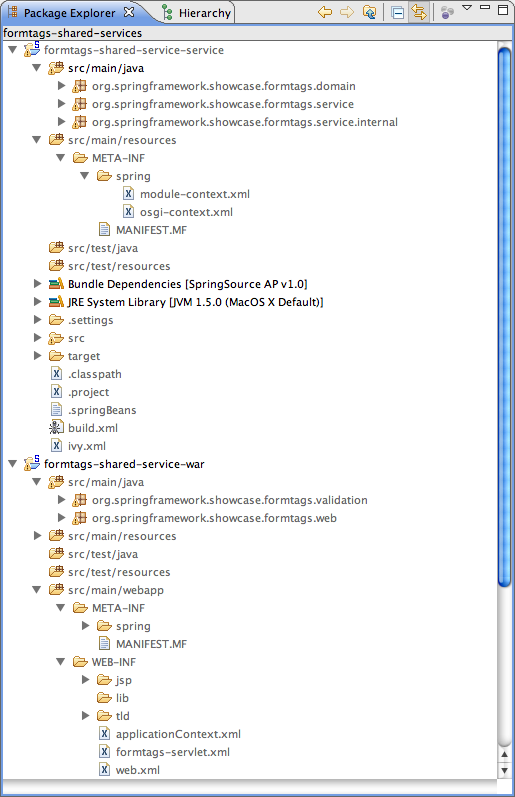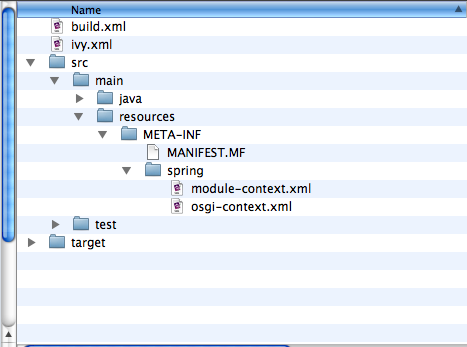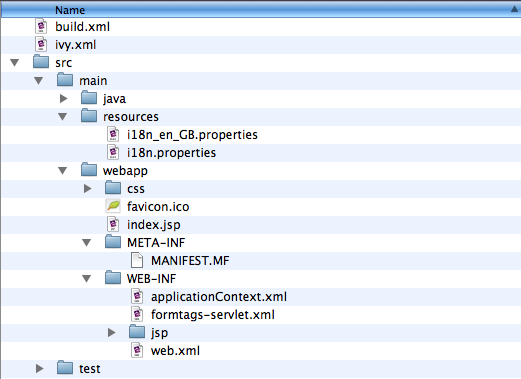The next step in the migration is to deploy the services as a separate
OSGi bundle which the WAR then references.
The Form Tags sample has a single service UserManager.
This scenario has two separate deployables, the service bundle and the WAR file.
The following image shows the two separate source trees:

![[Note]](images/note.gif) | Note |
|---|---|
Note that the WAR does not contain the .domain or
.service packages as these will be imported from the separate service bundle.
|
The responsibility of the first bundle (formtags-shared-services-service)
is to provide the API of the formtags service. This includes both the
domain and the service API. In the same way that imports are defined
in the /META-INF/MANIFEST.MF, so are exports.
The following is the /META-INF/MANIFEST.MF listing from the service bundle.
Manifest-Version: 1.0
Ant-Version: Apache Ant 1.7.0
Created-By: 1.5.0_13-119 (Apple Inc.)
Bundle-ManifestVersion: 2
Bundle-Name: FormTags Service (and implementation)
Bundle-SymbolicName: org.springframework.showcase.formtags.service-sha
red-services
Bundle-Vendor: SpringSource Inc.
Export-Package: org.springframework.showcase.formtags.service,org.spri
ngframework.showcase.formtags.domain
Import-Library: org.springframework.spring;version="[2.5.4,3.1.0)"
The symbolic name of this bundle is
org.springframework.showcase.formtags.service-shared-services.
Note that the name of the bundle typically describes the package
that the bundle primarily exports.
If you take a look at the repository/bundles/ext in the dm Server
directory, you'll see that names are almost always indicative of the contents of the bundle.
For this example, however, we have also appended
"-shared-services"
in order to avoid possible clashes with other bundle symbolic names.
You will see later that the PAR also contains a service bundle.
![[Note]](images/note.gif) | Note |
|---|---|
In OSGi, the combination of Bundle-SymbolicName
and Bundle-Version is used to uniquely identify
a bundle within the OSGi container. Furthermore, when you deploy
a bundle to the SpringSource dm Server, for example via the pickup
directory, a bundle's filename is also used to uniquely identify it for
the purpose of supporting hot deployment via
the file system.
|
As well as exporting types (i.e. the domain classes and service
API), the service bundle also publishes an implementation of the
UserManager. The actual implementation is
StubUserManager; however, that should remain an
implementation detail of this bundle.
The fact that this bundle publishes a service is not captured in
the /META-INF/MANIFEST.MF, as it is a Spring-DM concept.
The following image is of src/main/resources/spring.

As you can see there are two Spring configuration files: module-context.xml and
osgi-context.xml.
![[Tip]](images/tip.gif) | Tip |
|---|---|
These names are abitrary; however, they follow an informal convention:
module-context.xml typically bootstraps the Spring context
(usually delegating to smaller fine grained context files inside another directory), whilst
osgi-context.xml contains all the OSGi service exports and references.
|
The following is a listing of module-context.xml.
<?xml version="1.0" encoding="UTF-8"?> <beans xmlns="http://www.springframework.org/schema/beans" xmlns:xsi="http://www.w3.org/2001/XMLSchema-instance" xsi:schemaLocation=" http://www.springframework.org/schema/beans http://www.springframework.org/schema/beans/spring-beans-2.5.xsd"> <bean id="userManager" class="org.springframework.showcase.formtags.service.internal.StubUserManager"/> </beans>
As you can see, this simply defines a bean called userManager.
The following is a listing of osgi-context.xml.
<?xml version="1.0" encoding="UTF-8"?> <beans:beans xmlns="http://www.springframework.org/schema/osgi" xmlns:xsi="http://www.w3.org/2001/XMLSchema-instance" xmlns:beans="http://www.springframework.org/schema/beans" xsi:schemaLocation="http://www.springframework.org/schema/osgi http://www.springframework.org/schema/osgi/spring-osgi.xsd http://www.springframework.org/schema/beans http://www.springframework.org/schema/beans/spring-beans.xsd"> <service ref="userManager" interface="org.springframework.showcase.formtags.service.UserManager"/> </beans:beans>
This single bean definition exports the userManager
defined in module-context.xml to the
OSGi service registry and makes it available under the public
org.springframework.showcase.formtags.service.UserManager API.
The service bundle should now be ready to deploy on the dm Server.
So copy /dist/formtags-shared-services-services*
to the SERVER_HOME/pickup directory.
Output similar to the following should appear in the dm Server's console:
![[Note]](images/note.gif) | Note |
|---|---|
The console output has been reformatted to fit this document. |
[2009-07-01 15:05:03.511] fs-watcher
<SPDE0048I> Processing 'CREATED' event for file 'formtags-shared-services-service-2.0.0.RELEASE.jar'.
[2009-07-01 15:05:03.688] fs-watcher
<SPDE0010I> Deployment of 'org.springframework.showcase.formtags.service_shared_services' version '2.0.0.RELEASE' completed.
The WAR file now needs to access the types and service exported
by the service bundle. The following listing is the WAR's
/META-INF/MANIFEST.MF which imports the types
exported by the service bundle. The Import-Bundle
statement has also been extended to import org.springframework.osgi.core,
which is necessary in order to load an OSGi-enabled WebApplicationContext.
Manifest-Version: 1.0 Ant-Version: Apache Ant 1.7.0 Created-By: 1.5.0_13-119 (Apple Inc.) Bundle-ManifestVersion: 2 Bundle-SymbolicName: org.springframework.showcase.formtags.web-shared- services Bundle-Vendor: SpringSource Inc. Import-Package: org.springframework.showcase.formtags.domain,org.sprin gframework.showcase.formtags.service, com.springsource.server.web.dm;version="[1.0,2.1)" Import-Library: org.springframework.spring;version="[2.5.4,3.1.0)" Import-Bundle: com.springsource.org.apache.taglibs.standard;version="1 .1.2",org.springframework.osgi.core
In addition to importing the exported types of the service bundle,
the WAR must also obtain a reference to the UserManager
published by the service bundle. The following image shows the directory
structure of the Shared Services WAR.

As you can see in the above image, the Form Tags Shared Services WAR's
/WEB-INF/web.xml directory contains a standard web.xml
deployment descriptor, applicationContext.xml which defines the configuration
for the root WebApplicationContext, and
formtags-servlet.xml which defines the configuration specific to the
configured formtags DispatcherServlet.
As is typical for Spring MVC based web applications, you configure a ContextLoaderListener
in web.xml to load your root WebApplicationContext; however, to enable your
WebApplicationContext to be able to reference services from the OSGi Service Registry,
you must explicitly set the contextClass Servlet context parameter to the fully qualified
class name of a ConfigurableWebApplicationContext which is OSGi-enabled. When deploying
Shared Services WARs to the SpringSource dm Server, you should use
com.springsource.server.web.dm.ServerOsgiBundleXmlWebApplicationContext. This will
then enable the use of Spring-DM's <reference ... /> within your root
WebApplicationContext (i.e., in applicationContext.xml).
The following listing is an excerpt from /WEB-INF/web.xml.
<context-param>
<param-name>contextClass</param-name>
<param-value>com.springsource.server.web.dm.ServerOsgiBundleXmlWebApplicationContext</param-value>
</context-param>
<listener>
<listener-class>org.springframework.web.context.ContextLoaderListener</listener-class>
</listener>
The Form Tags Shared Services WAR contains a /WEB-INF/applicationContext.xml
file which is the default configuration location used to create the root
WebApplicationContext for Spring MVC's ContextLoaderListener.
![[Note]](images/note.gif) | Note |
|---|---|
As already mentioned, in the OSGi world, bundle configuration
takes place in the root /META-INF/ directory.
Typically Spring-DM powered configuration files will live
there as well (e.g., in /META-INF/spring/*.xml).
In a WAR, however, the root WebApplicationContext
loaded by ContextLoaderListener and the DispatcherServlet's
application context typically live in /WEB-INF/.
|
The following is the listing of the WAR's /WEB-INF/applicationContext.xml.
<?xml version="1.0" encoding="UTF-8"?> <beans:beans xmlns="http://www.springframework.org/schema/osgi" xmlns:xsi="http://www.w3.org/2001/XMLSchema-instance" xmlns:beans="http://www.springframework.org/schema/beans" xsi:schemaLocation="http://www.springframework.org/schema/osgi http://www.springframework.org/schema/osgi/spring-osgi.xsd http://www.springframework.org/schema/beans http://www.springframework.org/schema/beans/spring-beans.xsd"> <reference id="userManager" interface="org.springframework.showcase.formtags.service.UserManager"/> </beans:beans>
The single bean declaration is retrieving a service that implements
the org.springframework.showcase.formtags.service.UserManager
API from the OSGi Service Registry.
![[Tip]](images/tip.gif) | Tip |
|---|---|
| You might have been expecting a reference to the service bundle, but that isn't how OSGi works. OSGi provides a service registry, and this bean definition is accessing a service in that registry that meets the specified restriction (i.e. implements the specified interface). This leads to a very loosely coupled programming model: the WAR really doesn't care where the implementation comes from. |
![[Tip]](images/tip.gif) | Tip |
|---|---|
| What happens if there is no service at runtime? What if there are multiple services that match the criteria? Spring-DM provides a lot of configuration options, including whether or not the reference is mandatory, how long to wait for a service reference, etc. Please consult the Spring Dynamic Modules for OSGi home page for further information. |
One of the benefits of programming to interfaces is that you are decoupled from the actual implementation; Spring-DM provides a proxy. This has enormous benefits including the ability to dynamically refresh individual bundles without cascading that refresh to unrelated bundles.
To deploy the WAR, copy /dist/formtags-shared-services-war*
to the SERVER_HOME/pickup directory.
You should then see console output similar to the following:
![[Note]](images/note.gif) | Note |
|---|---|
The console output has been reformatted to fit this document. |
[2009-07-01 15:09:19.819] fs-watcher
<SPDE0048I> Processing 'CREATED' event for file 'formtags-shared-services-war-2.0.0.RELEASE.war'.
[2009-07-01 15:09:20.167] fs-watcher
<SPDE0010I> Deployment of 'org.springframework.showcase.formtags.web_shared_services' version '2' completed.
[2009-07-01 15:09:20.168] Thread-20
<SPWE0000I> Starting web bundle '/formtags-shared-services-war-2.0.0.RELEASE'.
[2009-07-01 15:09:20.647] Thread-20
<SPWE0001I> Started web bundle '/formtags-shared-services-war-2.0.0.RELEASE'.
Navigating to the appropriate link should render the welcome page.